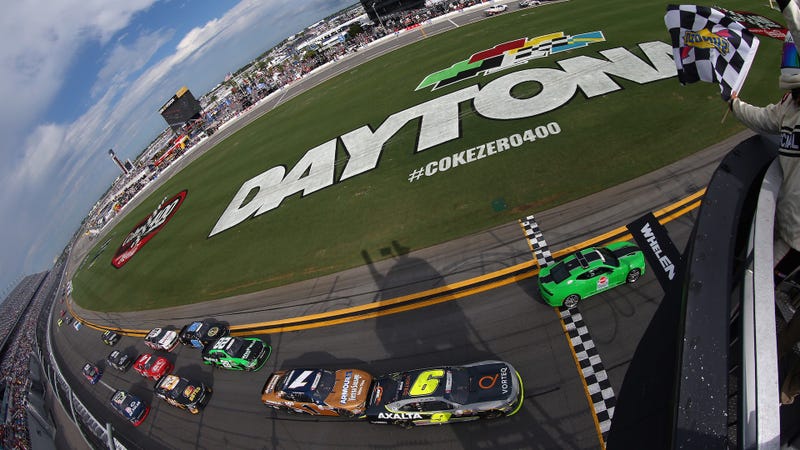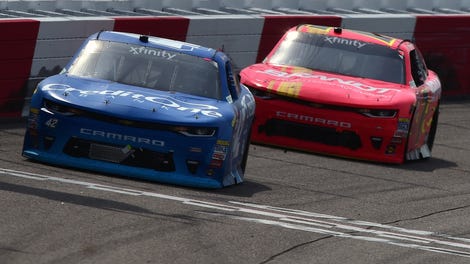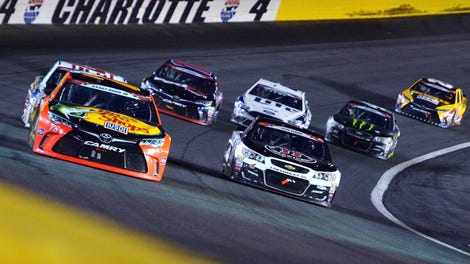
There’s a thing southern folks like to say, and surely you’ve heard it before: “If it ain’t broke, don’t fix it.” That’s what NASCAR did by making “overtime” rules at the start of the 2016 season, and it’s gone about as well as enrolling a cat in swim lessons. And maybe, just maybe, NASCAR’s starting to realize that.
It seems that way since NASCAR’s executive vice president, Steve O’Donnell, told NBC Sports that the sanctioning body is taking “a hard look” at moving the overtime line from its own designated spot on the race track to the start/finish line for the 2018 season.
That came after a controversial race-ending caution in the Xfinity Series race at Daytona International Speedway on Saturday, in which a wreck began what seemed like an eternity ahead of the line during an overtime finish. But NASCAR officials didn’t call the caution until after the field passed the line and well after several cars were sideways in the wall, giving William Byron the win.
If that didn’t make you raise your eyebrows, well, it should have. In addition to viewers’ displeasure, Dale Earnhardt Jr. said recently that even he thinks the overtime line should go—even after he “kind of helped come up with that idea.”
Here’s what O’Donnell said about things, from NBC Sports:
A point that has been made from tracks, O’Donnell said, is that many don’t have seats where the overtime line is — typically located on the backstretch or near the entrance of Turn 3.
“All those things, if you take the time and you put it up on a board and say what are the positives to this, there are not a ton of them,’’ O’Donnell said on the NASCAR on NBC podcast. “So I think if we get it back to the start/finish line and make sure the fans at least get that one full lap, that’s a direction we want to go.’’
In about as quick and non-confusing of a way possible, the overtime line started like this: NASCAR had a system for late-race cautions coming out and extending a race past its scheduled distance, which was called a “green-white-checkered” finish and consisted of two laps. The first lap was a regular green-flag lap, the second was a traditional white-flag lap and then officials waved the checkered.
There were three attempts at that before a caution would just end it, and, consistent with the existing NASCAR rules, the white flag meant the next flag ended it. So, if a caution came out after the white was waved, it ended the race and the leader at the time won.
The gray area in that system was in the waving of the flag. If the white waved around the same time as the caution, it was a murky call by NASCAR to decide the timing of the caution versus the waving of the flag. So, to make things more concrete, NASCAR changed the deciding factor from the white flag to a line: the overtime line.
The line would be at a different place on each track, mostly on the backstretch. It made the distance to the race-deciding spot on the track a lot shorter, but the terminology brought NASCAR one step closer to its obvious goal of being further associated with ball sports.
But it sure didn’t make things concrete.
When I first heard about the new rule, it sounded like a good deal. It came with unlimited attempts, and even I said that:
In essence, the new overtime rule is the same as the old rule with the addition of unlimited attempts. By defining a line on track, it takes out the ambiguity of relying on the when the flagperson flew the white flag if need be.
Then I saw the rule actually implemented in a race, and I realized the ambiguity simply changed spots on the track—just like the deciding factor in whether a caution would end the race or not—and perhaps got worse.
It’s hard not to get a weird feeling in your stomach when you watch a caution take as long as it did at the Daytona Xfinity Series race to come out, especially when there was a specific line the field had to pass to end the race. Having a concretely placed line actually made things murkier, since that allows officials to know exactly when the field will pass it.
With the white flag, the marker signifying an “official” point at which the next flag would end the race was subject to when the flagperson flew it. That gives a disconnect between officiating on whether to call a caution and the throwing of the next flag, which allows for more fair judgement due to the uncertainty.
It’s kind of like insider trading—you shouldn’t know what events will transpire before you make a call on whether to do something. So, really, the proposed fix O’Donnell mentioned won’t change anything. It’ll just give more time for racing in between flags in a flawed system.
And sure, the old system had its flaws. Sometimes, officials had to decide based on a waving motion whether or not the white flag had been thrown yet. Not everyone would agree with the decision, but no one ever agrees unanimously. It’s better to deliberate afterward than to know an outcome before it happens.
So, like we southerners say, just don’t fix it if it’s not broken. It can be a little flawed, just like that slightly crooked finger on your right hand, but that doesn’t mean things need to be made “right”—especially if the fix doesn’t help.
I’d welcome the old system back with a big smile and a firm handshake, crooked finger and all.






